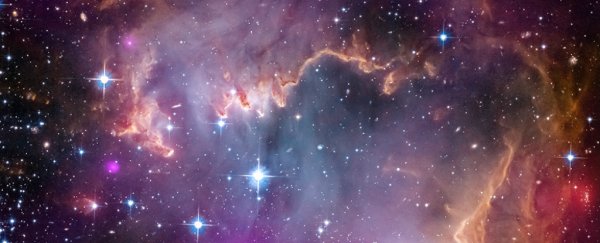Every time we post a space photo, there's at least a handful of people in the comments with the same kind of response: "Space isn't violet!"; "This isn't how galaxies would look to the naked eye"; "Stop posting fake images!"
Well, apparently it's not just us, because an astrophysicist has spoken out over at Space.com this week, asking people to please stop complaining about the colours in NASA images, because they actually need them to do science.
Paul Sutter, an astrophysicist from the Ohio State University and chief scientist at the COSI science centre, explains that there's a good reason for why NASA needs to enhance space images - and it's not to get more likes on Facebook.
"Researchers take pictures of stuff in space to learn about how it works, and some higher contrast here or a little brightening over there can help us understand complex structures and relationships within and between them," he writes.
"So don't blame NASA for a little photo enhancement touching up; they're doing it for science."
But let's step back for a second, because if those Hubble photos we all love are enhanced, then what colour is space anyway, and how does making a distant nebula look green, orange, or pink actually help researchers?
For starters, it's almost impossible to say objectively what colour space is, because it all depends on what kind of eyes you're looking at it with.
Space emits many wavelengths of light - including a lot of blue and red light that our human eyes can see - but also ultraviolet light, gamma rays, and X-rays, which remain invisible to us.
NASA's Hubble Space Telescope, which takes most of the jaw-dropping space images we find and share on the internet, actually doesn't 'see' any colour at all - it can only take images in black and white.
As the Hubble site explains, similar to a digital camera, the space telescope uses a charge-coupled device (CCD) to record incoming photons of light.
The CCD doesn't record any colour, but Hubble has filters that it can apply to only let in a specific wavelength - or colour - of light. By taking images of the same object (say, a galaxy) using different filters, researchers can get a pretty good idea of what wavelengths of light are being emitted by which structures.
So how do they take that information and turn it into the gorgeous colour images we see?
"Creating colour images out of the original black-and-white exposures is equal parts art and science," the Hubble site explains. "We often use colour as a tool, whether it is to enhance an object's detail or to visualise what ordinarily could never be seen by the human eye."
What that means is that often images will be left mostly red and blue, which is what they would look like to human eyes.
But sometimes they also need to know which parts of a galaxy are spitting out X-rays, and which are emitting infrared light, so then those wavelengths are assigned colours that we can see.
"Elements when they're heated will glow in very specific wavelengths of light," writes Sutter. "Sometimes that light is within human perception but will be washed out by other colours in the picture, and sometimes the light's wavelength is altogether beyond the visible."
"But in either case, we want to map out where that element is in a particular nebula or disk," he adds. "So scientists will highlight that feature to get clues to the origins and structure of something complex."
So there you have it - no one's doing it to betray you or make clickbait, these guys are just trying to do their jobs. And thanks to Hubble's 'artificial' images, we've learnt so much more about the Universe and the structures within it.
Oh, and for any purists out there still feeling duped that NASA adds colour to their photographs, Sutter would like to remind you that just looking through a telescope gives you a 'not real' view of space, anyway.
That's because telescopes pick up light that's a whole lot fainter than the human eye can see, and then it has to focus all those extra photons into a spot that can fit into our iris.
"That act of focusing also magnifies images, making them appear much larger than in real life," Sutter writes. "So, already, a telescope is giving you an artificial view of the heavens."
